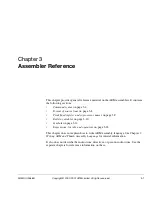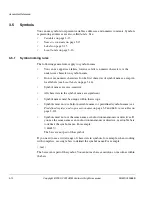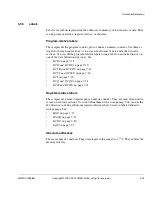
Assembler Reference
ARM DUI 0068B
Copyright © 2000, 2001 ARM Limited. All rights reserved.
3-15
3.5.5
Labels
Labels are symbols representing the addresses in memory of instructions or data. They
can be program-relative, register-relative, or absolute.
Program-relative labels
These represent the program counter, plus or minus a numeric constant. Use them as
targets for branch instructions, or to access small items of data embedded in code
sections. You can define program-relative labels using a label on an instruction or on
one of the data definition directives. See:
•
DCB
on page 7-18
•
DCD and DCDU
on page 7-19
•
DCFD and DCFDU
on page 7-21
•
DCFS and DCFSU
on page 7-22
•
DCI
on page 7-23
•
DCQ and DCQU
on page 7-24
•
DCW and DCWU
on page 7-25.
Register-relative labels
These represent a named register plus a numeric constant. They are most often used to
access data in data sections. You can define them with a storage map. You can use the
EQU
directive to define additional register-relative labels, based on labels defined in
storage maps. See:
•
MAP
on page 7-15
•
SPACE
on page 7-17
•
DCDO
on page 7-20
•
EQU
on page 7-57.
Absolute addresses
These are numeric constants. They are integers in the range 0 to 2
32
–1. They address the
memory directly.
















































